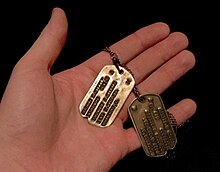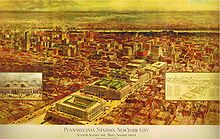Monel: Difference between revisions
| Line 78: | Line 78: | ||
|Monel 401|| |||| N04401||28-34|||| ||2.5 max||2.0 max||||63 min |
|Monel 401|| |||| N04401||28-34|||| ||2.5 max||2.0 max||||63 min |
||
|- |
|- |
||
|Monel 404|| || |
|Monel 404|| |||| N04404||28-34|||| ||2.5 max||2.0 max||||63 min |
||
|- |
|- |
||
|Monel K-500|| ||B 865|| N05500||27-33||2.3-3.15||0.35-0.85||2.0 max||1.5 max||||63 min |
|Monel K-500|| ||B 865|| N05500||27-33||2.3-3.15||0.35-0.85||2.0 max||1.5 max||||63 min |
||
Revision as of 12:49, 16 June 2014

Monel is a series of nickel alloys, primarily composed of nickel (up to 67%) and copper, with some iron and other trace elements. Monel was created by David H. Browne, chief metallurgist for International Nickel Co. Monel alloy 400 is binary alloy of the same proportions of nickel and copper as is found naturally in the nickel ore from the Sudbury (Ontario) mines and is therefore considered a puritan alloy. Monel was named after company president Ambrose Monell, and patented in 1906.[2] One L was dropped, because family names were not allowed as trademarks at that time.[1] The name is now a trademark of Special Metals Corporation.
Properties
Compared to steel, Monel is very difficult to machine as it work-hardens very quickly. It needs to be turned and worked at slow speeds and low feed rates. It is resistant to corrosion and acids, and some alloys can withstand a fire in pure oxygen. It is commonly used in applications with highly corrosive conditions. Small additions of aluminium and titanium form an alloy (K-500) with the same corrosion resistance but with much greater strength due to gamma prime formation on aging. Monel is typically much more expensive than stainless steel.
Monel alloy 400 has a specific gravity of 8.83, an electrical conductivity of approximately 34% IACS, and (in the annealed state) a hardness of 65 Rockwell B.[3]
Uses
Aerospace applications
In the 1960s, Monel metal found bulk uses in aircraft construction, especially in making the frames and skins of experimental rocket planes, such as the North American X-15, to resist the great heat generated by aerodynamic friction during extremely high speed flight. Monel metal retains its strength at very high temperatures, allowing it to maintain its shape at high atmospheric flight speeds, a trade off against the increased weight of the parts due to Monel's high density.
Oil refining
Monel is used in the section of Alkylation units in direct contact with concentrated HF.
Marine applications
Monel's corrosion resistance makes it ideal in applications such as piping systems, pump shafts, seawater valves, trolling wire, and strainer baskets. Some alloys are completely non-magnetic and are used for anchor cable aboard minesweepers,[4] housings for magnetic-field measurement equipment. In recreational boating, Monel wire is used to seize shackles for anchor rodes, Monel is used for water and fuel tanks, and for under water applications. It is also used for propeller shafts and for keel bolts.
However, because of the problem of electrolytic action in salt water (also known as Galvanic corrosion), in shipbuilding monel must be carefully insulated from other metals such as steel. The New York Times of August 12, 1915 published an article about a 215 foot yacht, "the first ship that has ever been built with an entirely monel hull," that "went to pieces" in just six weeks and had to be scrapped, "on account of the disintegration of her bottom by electrical action." The yacht's steel skeleton deteriorated due to electrolytic interaction with the monel.[5]
In seabird research, and bird banding or ringing in particular, Monel has been used to make bird bands or rings for many species such as albatross that live in a corrosive sea water environment.[6]
Monel is also used for safety wiring in the aircraft industry to ensure that fasteners cannot come undone.
Musical instruments
Monel is used as the material for valve pistons in some higher quality musical instruments such as trumpets, tubas and French horn rotors. RotoSound introduced the use of Monel for electric bass strings in 1962, and these strings have been used by numerous artists, including Steve Harris of Iron Maiden, The Who, Sting, John Deacon, and John Paul Jones. Monel was in use in the early 1930s by other musical string manufacturers, such as Gibson Guitar Corporation, who continue to offer them for mandolin as the Sam Bush signature set.
Directional Drilling
Monel drill collars are used in surveying oil wells. Monel collars are used in drilling directional wells which require the well to be steered. Their use permits faster and more accurate surveys, reduce hazards, and decreases the cost of drilling directional or controlled oil wells. The reduced cost comes from the ability of real time surveys from a MWD tool which has magnetometers built into them. The magnetometers if not surrounded by non-magnetic material (monel, inconel, Cu-Be, or non-magnetic stainless) will be unable to read the earth’s magnetic field without interference and will give an incorrect reading.
Monel is very rarely used in present day directional drilling collars. They are still referred to as monel collars based on tradition and misinformation. Monel has been substituted with 316 and other non-magnetic stainless materials due to cost.
Other

The good resistance against corrosion by acids and oxygen makes monel a good material for the chemical industry. Even corrosive fluorides can be handled within monel apparatus; this was done in an extensive way in the enrichment of uranium in the Oak Ridge Gaseous Diffusion Plant. Here most of the larger diameter tubing for the uranium hexafluoride was made from monel.[7] Regulators for reactive cylinder gases like hydrogen chloride form another example, where PTFE is not a suitable option when high delivery pressures are required. These will sometimes include a Monel manifold and taps prior to the regulator that allow the regulator to be flushed with a dry, inert gas after use to further protect the equipment.
Monel was used for US Military dog tags in WWI and WWII.

Monel is often used for kitchen sinks and in the frames of eyeglasses. It has also been used for firebox stays in fire-tube boilers.
Parts of the Clock of the Long Now, which is intended to run for 10,000 years, are made from Monel because of the corrosion resistance without the use of precious metals.[8]
Monel was used for much of the exposed metal used in the interior of the Bryn Athyn Cathedral in Pennsylvania, religious seat of the General Church of the New Jerusalem. This included large decorative screens, doorknobs, etc.[1] Monel also has been used as roofing material in buildings such as the original Pennsylvania Station in New York City.[1]

The 1991 - 1996 Acura (Honda) NSX came with a key made of Monel.[9]
Oilfield applications include using Monel (rarely - see directional drilling above) in both flex and slick collars. Instruments (magnetometers or compass) which measure the Earth's magnetic field to obtain a magnetic direction are placed in the non-magnetic collar which isolates sensors from the magnetic pull of drilling tools located above and below the non-magnetic collars. They are often referred to as "monel collars" as that was the first material used to make the collars and the name stuck.
Monel is also used as a protective binding material on the outside of western style stirrups.
Monel is used by Arrow Fastener Co., Inc. for rustproof T50 staples.
Monel has also been used in Kelvinator refrigerators.
Monel was used in the Baby Alice Thumb Guard, a 1930s-era anti-thumb-sucking device. [10]
Alloys
| Trade Name | ASME P Group | ASTM/AISI
Alloy type |
UNS | %Cu | %Al | %Ti | %Fe | %Mn | %Si | %Ni |
|---|---|---|---|---|---|---|---|---|---|---|
| Monel 400 | B 127, B 164 | N04400 | 28-34 | 2.5 max | 2.0 max | 63 min | ||||
| Monel 401 | N04401 | 28-34 | 2.5 max | 2.0 max | 63 min | |||||
| Monel 404 | N04404 | 28-34 | 2.5 max | 2.0 max | 63 min | |||||
| Monel K-500 | B 865 | N05500 | 27-33 | 2.3-3.15 | 0.35-0.85 | 2.0 max | 1.5 max | 63 min | ||
| Monel R-405 | B 164 | N04405 | 28-34 | 2.5 max | 2.0 max | 0.5 max | 63 min |
See also
References
- ^ a b c d Von Margot Gayle, David W. Look, John G. Waite (1992). "Monel". Metals in America's historic buildings: uses and preservation treatments. DIANE Publishing. pp. 39–41. ISBN 978-0-16-038073-0.
{{cite book}}: CS1 maint: multiple names: authors list (link) - ^ Ambrose Monell U.S. patent 811,239 Issue date: Jan 1906
- ^ Nickel Alloy 400 (Monel)
- ^ Teeple, H. O. (1953). "Nickel and High-Nickel Alloys". Industrial & Engineering Chemistry. 45: 2215. doi:10.1021/ie50526a033.
- ^ "New York Times, August 12, 1915: Big Yacht Now Junk After Six Weeks Use". The New York Times. August 12, 1915. Retrieved May 13, 2010.
- ^ Ludwig, James P. (1981). "Band Wear and Band Loss in the Great Lakes Caspian Tern Population and a Generalized Model of Band Loss". Colonial Waterbirds. 4: 174–18. doi:10.2307/1521133. JSTOR 1521133.
- ^ Milford, Robert (1958). "Engineering Design of Oak Ridge Fluoride Volatility Pilot Plant". Industrial & Engineering Chemistry. 50: 187. doi:10.1021/ie50578a032.
- ^ Beech, Martin (2007). "The Clock of the Long Now — A Reflection" (PDF). The Journal of the Royal Astronomical Society of Canada. 101 (1): 4–5.
- ^ http://www.nsxprime.com/FAQ/General/nsxkeys.htm
- ^ http://graphic-design.tjs-labs.com/show-picture?id=1097010675
Bibliography
- Shoemaker, Lewis E. (2006). "A century of monel metal: 1906–2006". JOM. 58: 22. doi:10.1007/s11837-006-0077-x.
{{cite journal}}:|first2=missing|last2=(help)
